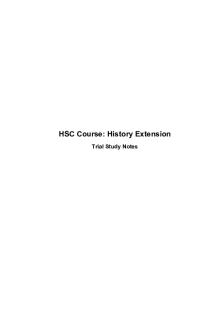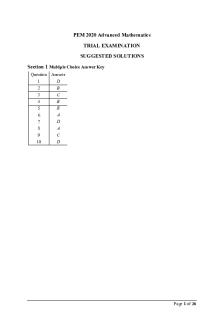Practice HSC Trial Online Advanced Mechanics 2021 PDF

| Title | Practice HSC Trial Online Advanced Mechanics 2021 |
|---|---|
| Course | Physics |
| Institution | Higher School Certificate (New South Wales) |
| Pages | 6 |
| File Size | 307.2 KB |
| File Type | |
| Total Downloads | 122 |
| Total Views | 153 |
Summary
test...
Description
THE ILLAWARRA GRAMMAR SCHOOL
Year 12 Physics Practice HSC Trial Online Advanced Mechanics 2021
General Instructions ● Reading time – 3 minutes ● Working time – 45 mins ● Write using black pen ● Draw diagrams using pencil ● For questions in Section II, show all relevant working in questions involving calculations ● NESA-approved calculators may be used Write your Student Number at the top of each of your pages of work.
Total Marks – 25 Section I - 5 marks ● Attempt Questions 1 - 5 ● Allow about 9 minutes for this section Section II – 20 marks ● Attempt Questions 6 – 9 ● Allow about 36 minutes for this section
Instructions
Answer the questions on your own working paper.
Show all relevant working in questions involving calculations.
On your working paper, clearly indicate which questions you are answering.
At the end of the time photograph your pages of work and submit them to the appropriate submission section in OLLE.
Section I – 5 marks Attempt Questions 1-5 Allow about 9 minutes for this section 1. Curved train tracks are banked so that, to an occupant in the trains: (A)
the gravitational force is matched by the required centripetal
force. (B)
the centripetal force is equal to the normal force.
(C)
the normal force contributes to the required centripetal force.
(D)
the normal force aligns with the gravitational force.
2. The flightpath of a projectile fired over level ground is shown:
The projectile has minimum speed at point: (A)
W
(B)
X
(C)
Y
(D)
Z
3. Two satellites, A and B are orbiting Earth at different altitudes, as shown.
Which comparison of the satellites’ orbital velocities, orbital periods and centripetal accelerations is correct?
Orbital velocity
Orbital period
Centripetal acceleration
(A)
A is greater
B is greater
B is greater
(B)
B is greater
A is greater
A is greater
(C)
B is greater
B is greater
B is greater
(D)
A is greater
B is greater
A is greater
4. Two bike riders have a race over a straight track. The blue bike starts from rest and accelerates uniformly at 2.0 m s-2, while the red bike starts from the same position but with an initial speed of 5.0 m s-1 and then accelerates uniformly at 1.6 m s-2. How far from the start line are the two bikes again side by side? (A)
25 m
(B)
625 m
(C)
80 m
(D)
32 m
5. The total potential energy of a satellite with mass 6.50 x 103 kg when orbiting Earth at an altitude of 2.00 x 103 km is closest to: (A)
-3.11 x 1011 J
(B)
-3.11 x 1014 J
(C)
-1.30 x 1015 J
(D)
-1.55 x 1011 J
Section II – 20 marks Attempt Questions 6 – 9 Allow about 36 minutes for this section Question 6 (5 marks) Projectile motion can be modelled by analysing the horizontal and vertical components separately. (a)
Show that the maximum height reached by a projectile, hmax, is given by: hmax
u 2 sin 2 2g
given: u = initial launch speed; θ = launch angle, and g = acceleration due to gravity. (2 marks)
(b)
A certain projectile is always launched with a speed of 40.0 m s-1. The projectile must land on a target which is exactly 140.0 m away horizontally from the launch position. The projectile is launched at an angle of 30°. Find whether the projectile lands on, falls short of, or travels further than the target. (3 marks)
Question 7 (4 marks) One solution to the problem of extended periods of time in a weightless environment is to design a spacecraft which is rotating. The rotation will give rise to an “artificial gravity”.
Quantitatively derive a viable solution to this problem so that the spacecraft could rotate and the astronauts in the crew quarters would measure an artificial gravitational acceleration of 9.8 m s-2. The period of rotation for the proposed solution cannot be less than one minute, or the astronauts will become disoriented and giddy. Question 8 (2 marks) The torque required to turn a bolt is 200 N m. Find the force, F, exerted on a so that the bolt
required to be spanner as shown will turn.
Question 9 (9 marks) The orbits of satellites such as GPS must be known very precisely. With reference to the total energy of a satellite and Kepler’s Laws, discuss how satellites’ orbits can be predicted and maintained.
End of Exam
Please photograph your pages of work and submit them to the Practice HSC Trial Online Advanced Mechanics 2021 submission section in OLLE....
Similar Free PDFs

2021 HSC Trial Solutions
- 22 Pages

HSC Economics Mock Trial Paper 2021
- 12 Pages

2020 Chemistry HSC Trial
- 52 Pages

HSC Trial Notes Module A
- 8 Pages

2018 Trial HSC Exam Timetable
- 2 Pages

2020 Biology HSC Trial Examination
- 27 Pages

English (Advanced) HSC Glossary
- 2 Pages

HSC History Extension Trial Notes
- 28 Pages

hsc cssa trial economics paper
- 18 Pages

HSC Trial notes Module B
- 18 Pages
Popular Institutions
- Tinajero National High School - Annex
- Politeknik Caltex Riau
- Yokohama City University
- SGT University
- University of Al-Qadisiyah
- Divine Word College of Vigan
- Techniek College Rotterdam
- Universidade de Santiago
- Universiti Teknologi MARA Cawangan Johor Kampus Pasir Gudang
- Poltekkes Kemenkes Yogyakarta
- Baguio City National High School
- Colegio san marcos
- preparatoria uno
- Centro de Bachillerato Tecnológico Industrial y de Servicios No. 107
- Dalian Maritime University
- Quang Trung Secondary School
- Colegio Tecnológico en Informática
- Corporación Regional de Educación Superior
- Grupo CEDVA
- Dar Al Uloom University
- Centro de Estudios Preuniversitarios de la Universidad Nacional de Ingeniería
- 上智大学
- Aakash International School, Nuna Majara
- San Felipe Neri Catholic School
- Kang Chiao International School - New Taipei City
- Misamis Occidental National High School
- Institución Educativa Escuela Normal Juan Ladrilleros
- Kolehiyo ng Pantukan
- Batanes State College
- Instituto Continental
- Sekolah Menengah Kejuruan Kesehatan Kaltara (Tarakan)
- Colegio de La Inmaculada Concepcion - Cebu





